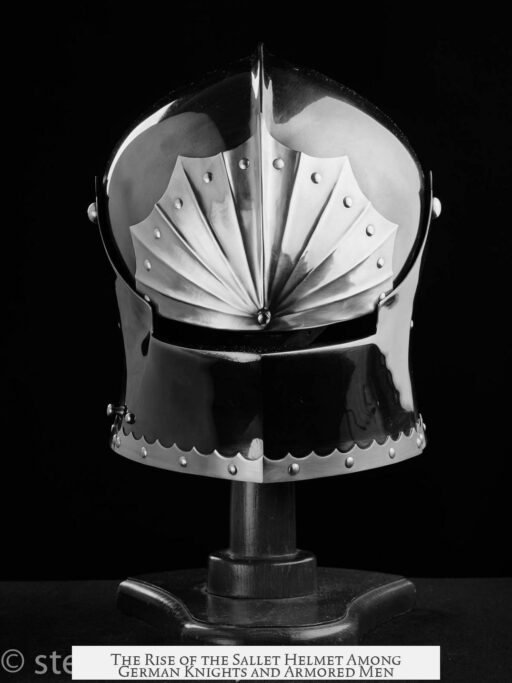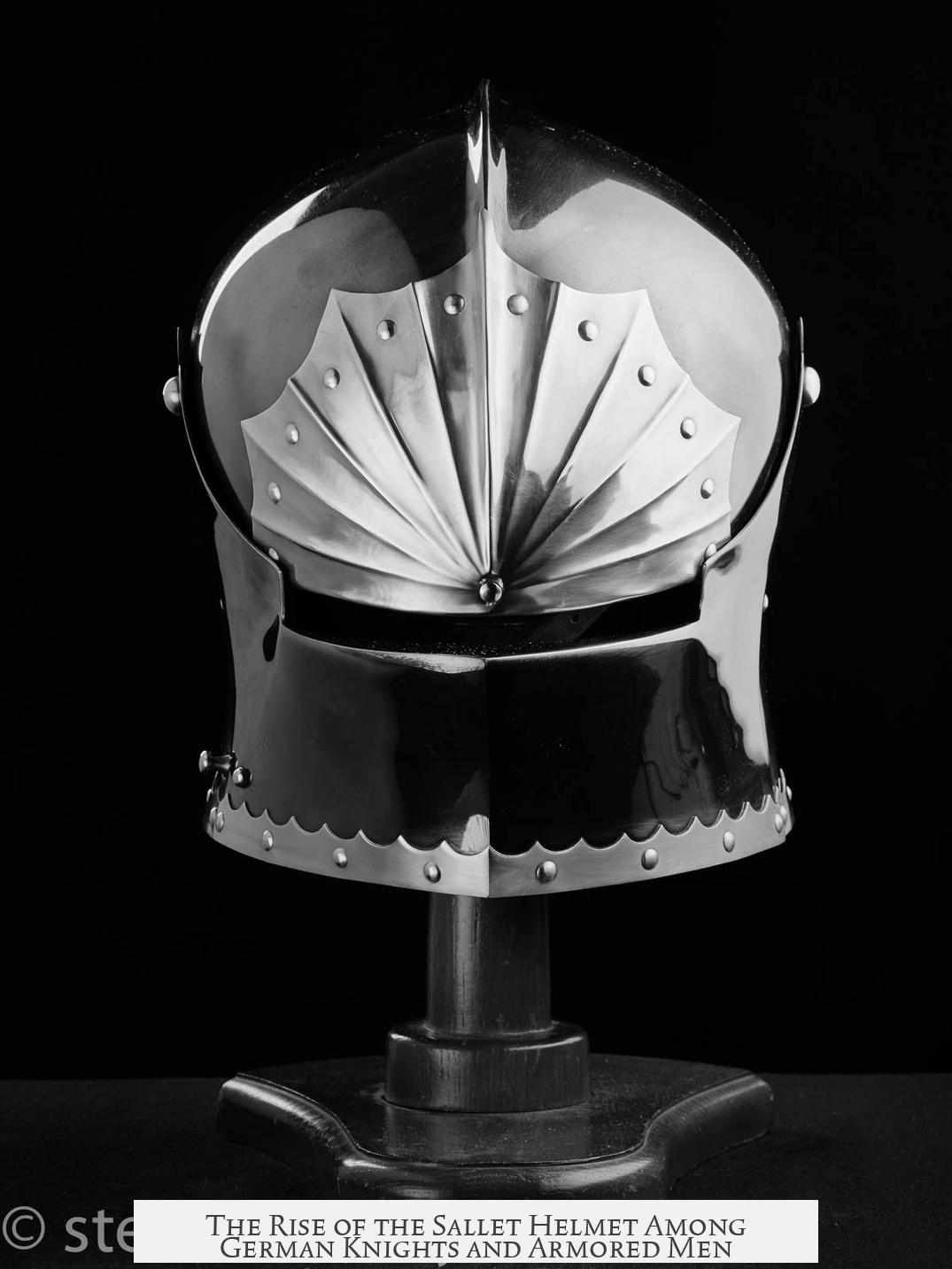The Sallet helmet became near universally used by armored German men at arms and knights because it offered superior flexibility, neck protection, and comfort compared to earlier helmets like the great bascinet. Germany adopted the sallet later than other European regions but embraced it enthusiastically by the late 15th century, leading to its dominance in German knightly armor both in reality and in artistic depictions.
The sallet was widely used across Western Europe, from central and northeastern Europe to Spain. It was common in England and the Low Countries during the late 15th century. Despite popular belief, the sallet was not uniquely German but rather part of a broad medieval European armor trend.
Initially, men at arms across Europe, including Germany, wore the great bascinet. This helmet provided rigid neck protection but significantly limited head movement. The rigidity became impractical for combat, especially on horseback where situational awareness mattered.
The sallet addressed these issues effectively. Its design enabled freer head movement by allowing the wearer to pivot the helmet around their neck. The visor could be raised or lowered for vision and ventilation, and the long tail protected the back of the neck without restricting motion. These features combined flexibility, protection, and comfort in a way that the great bascinet did not.
Germany adopted the sallet after England and the Low Countries but did so enthusiastically from around 1460 onward. By the late 15th century, sallets dominated as the knightly helmet in German lands. This period also saw numerous surviving sallets come from German workshops, creating a strong physical legacy that shapes modern perceptions.
The continued use of sallets in Germany extended into the early 16th century, longer than in most other regions, where newer helmets like the close helm and armet replaced it sooner. Iconic artworks, notably Albrecht Dürer’s “The Knight, the Devil and Death,” feature knights wearing sallets, reinforcing the helmet’s symbolic association with German knights.
German jousting traditions also favored the sallet, which helped preserve its use in ceremonial and tournament contexts. These cultural factors contributed to the helmet being recognized as “German” despite its pan-European origins.
Survival bias also plays a role. More German armor from the late 15th century survives than armor from England, France, or the Low Countries. This abundance of German sallets in museums and collections further cements the stereotype of the sallet as a German helmet. Meanwhile, Italian knights preferred the armet over the sallet and great bascinet, partly due to fashion and their distinct combat style, focusing on heavy mounted shock combat.
Italian armets provided a higher level of protection with fewer gaps than sallets, though sallets offered more flexibility. This difference in regional preferences contributed to the divergent helmet styles seen across Europe.
| Factor | Contribution to Sallet Popularity in German Lands |
|---|---|
| Flexibility | Allowed freer head movement; better situational awareness |
| Neck Protection | Long tail protected neck without limiting motion |
| Comfort | Adjustable visor helped with vision and ventilation |
| Late but Enthusiastic Adoption | Adopted after England but became widespread quickly |
| Cultural Factors | Used in jousts and depicted in iconic German artworks |
| Archaeological Survival Bias | More German sallets survive, influencing modern perceptions |
| Distinct Regional Trends | Italians favored armets, reinforcing sallet as “German” |
The popular idea that the sallet is a distinctly “German” helmet stems less from medieval reality and more from the helmet’s extended use in Germany, cultural depictions, and the survival of many German-made examples. In truth, the sallet was a widespread helmet choice across Europe, valued for its balance of protection, comfort, and mobility.
- Sallets improved head mobility and neck protection compared to bascinets.
- Germany adopted and embraced the sallet later but extensively in the late 15th century.
- Iconic German artworks and jousting traditions preserved the sallet’s image.
- Survival of numerous German sallets skews modern perceptions.
- Italian knights preferred the armet, influencing regional helmet distinctions.
Why did the Sallet helmet become popular among German men at arms despite its origins in other regions?
The Sallet was widely used in Western Europe before Germany adopted it. Germany embraced it enthusiastically after 1460, valuing its flexibility and protection. The helmet suited German battlefield needs well.
What made the Sallet helmet better than the earlier great bascinet for German knights?
Unlike the rigid great bascinet, the Sallet allowed freer head movement. Its visor adjusted for better vision and ventilation, and the long tail protected the neck without restricting movement. These features made it more practical.
Why is the Sallet helmet often considered “German” despite being common elsewhere?
This comes from cultural stereotypes and late German adoption. German knights wore Sallets longer than others, and surviving German armor collections preserve many Sallets, reinforcing the link. Famous artworks also shaped this idea.
Did German knights use the Sallet helmet longer than other European knights?
Yes, German men at arms wore Sallets into the early 16th century, while other regions had moved on to helmets like the close helm or armet. This extended use helped cement the Sallet’s association with Germany.
How did the design of the Sallet balance protection and comfort for German soldiers?
The Sallet offered solid neck coverage with its long tail and an adjustable visor. It protected well without limiting head movement, making it comfortable and functional for active combat situations.
Why didn’t Italian knights adopt the Sallet as widely as German knights?
Italian knights preferred the armet, which offered tighter protection with fewer gaps. Fashion and mounted combat tactics in Italy favored the armet, while German knights valued the Sallet’s flexibility more.




